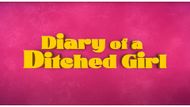Diary of a Ditched Girl dropped on Netflix on September 11, 2025. The Swedish rom-com grabs your attention right away with its main character, Amanda, 31, who is stumbling through the god-awful chaos that is modern dating in Malmö.
What makes it work isn’t just the jokes (though there are plenty), but also how painfully real everything feels. Amanda’s love life is a total trainwreck. She gets dumped, overshares, and probably sends those "why did I do that?" texts at 3 am.
Amidst all this, some moments hit you right in the feels out of nowhere. That’s what makes Amanda actually stick with you: she is a bit of a disaster, but she is funny and also super raw. You don’t just root for her, you feel like you are her on your worst days. Or, your most hopeful ones, perhaps.
However, the big question on everyone’s lips is: Is Diary of a Ditched Girl based on a book, and what is the real drive by Netflix to come up with a screen adaptation? Let us dig in.
Is Diary of a Ditched Girl based on a book?

The short answer is yes. Diary of a Ditched Girl is directly off the pages of a semi-autobiographical novel of Amanda Romare, cheekily titled Halva Malmö består av killar som dumpat mig, which roughly translates to "Half of Malmö’s Men Have Dumped Me."
The book was an instant success when it was published in 2021. It was raw, funny, and brutally honest, sparing no punches in its depiction of single womanhood and the rollercoaster that is modern dating. Its voice appealed to readers since it seemed lived in, not imagined: a collection of embarrassing moments, heartbreaks, and discoveries that could only be told by a person who had experienced them.
That someone, of course, is Romare herself. Amanda’s character in the show is not just loosely inspired by her; she is, in large part, Romare’s alter ego. According to Moviedelic, the author has admitted that nearly 90% of the book’s content is drawn from her own life.
Every misstep, every disastrous date, every moment of vulnerability grew out of over a decade of her own romantic misadventures. That honesty is what gave the novel its power, and that is also what made it irresistible as the blueprint for a television adaptation.
The transition to screen was courtesy of Netflix and directors Emma Bucht and Susanne Thorson, who turned Romare’s writing into a series. The reason it works is that it never loses the book’s characteristic balance of comedy and tender drama.
It neither shies away from Amanda’s experiences nor wallows in misery. Rather, it finds a balance between rejection and grit; humor and heartbreak amid the backdrop of online dating, an age of apps and fleeting encounters with perpetual reminders that one’s worth is always in the balance while searching for love.
About Diary of a Ditched Girl

Diary of a Ditched Girl follows Amanda, a 31-year-old woman stumbling, running, and sometimes crashing through the uncertain world of dating in Malmö, Sweden. After months of celibacy (and a horrifying confrontation when she’s flashed in a park), Amanda dives back into the world of dating with equal measures of hope and desperation.
What follows is a series of awkward first meetings, discouraging flings, and fragile glimmers of hope all scored to the beat of dating apps, ghosting, and fleeting connections characteristic of today’s world of love.
Amanda herself is a mix of contradictions. She’s vulnerable yet sharp, funny yet quietly bruised, and resilient enough to pick herself up after every fall. Around her is a circle of support: her sister Adina and a group of friends who bring their own stories of heartbreak, self-discovery, and confidence struggles.
These relationships ground Amanda, even as she wrestles with insecurities and complicated family dynamics, from a neglectful father to the tender yet sometimes strained bond she shares with Adina.
Every other episode brings a new man into the dating life of Amanda, most of them with a funny nickname that describes their particularities. We have the former Scientologist with the heavy baggage, the men who arrive and leave in ridiculous or devastating ways, and Emil, the childhood crush that seems like the real one. In Emil, Amanda discovers something that seems real, but her insecurities and mistakes haunt her journey.
Diary of a Ditched Girl succeeds on its mixture of comedy and heartbreak. It borders on the cringe-meets-laugh-out-loud catastrophes of dating and even takes a few minutes to have raw, emotional scenes that unveil the greatest fears that Amanda holds. By so doing, it produces a kind of romance that is refreshingly real for TV.
Rather than glittery happy-ever-afters, it tells us what it is like to cling to self-respect and to strike a balance between independence and desire, while continuing to show up when the odds are stacked against you.
Family dynamics are another layer. In this case, Amanda’s strained relationship with her father. His absence and abandonment haunt her throughout her adult life in terms of how she defines herself and the world around her.
During the series finale of Diary of a Ditched Girl, these threads come together with Amanda beginning to directly face her family problems, an opportunity for character evolution. It is less about tying things up with a romantic ribbon and more about Amanda gaining the strength to assert happiness on her terms, whether or not it includes love.
Also read: Will Diary of a Ditched Girl Season 2 happen? Possibilities explored
